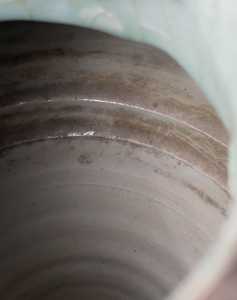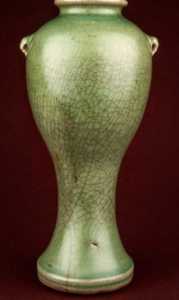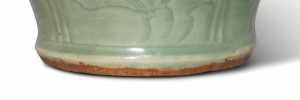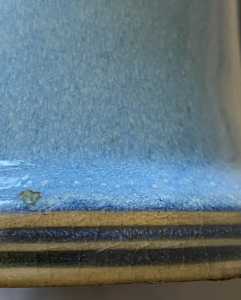The Chinese and Asian Art Forum. For Fans, Collectors and Dealers.
 Basic Rules For the BidAmount Asian Art Forum: Talk about whatever you want. You can even discuss and offer things that are for sale if they are authentic. Maximum image file size per post is 2 MB. Images of 700pxl x 700pxl are optimal if saved at a medium resolution. Be respectful of others and enjoy yourself. Click the YouTube link for a brief tutorial on using the forum. You can also EMBED Videos by cutting and pasting from You-Tube, Vimeo etc.
Basic Rules For the BidAmount Asian Art Forum: Talk about whatever you want. You can even discuss and offer things that are for sale if they are authentic. Maximum image file size per post is 2 MB. Images of 700pxl x 700pxl are optimal if saved at a medium resolution. Be respectful of others and enjoy yourself. Click the YouTube link for a brief tutorial on using the forum. You can also EMBED Videos by cutting and pasting from You-Tube, Vimeo etc.
NOTE: To post an item or add a new post, click open the category title from the FORUM LIST, and CLICK the Blue ADD TOPIC button.
Are the ridges slightly concaved like a groove made from a fingertip, and spiraling up from the bottom?
That's what they are: Grooves left by the potter's fingertip as they thinned the walls of the vase by applying pressure from the inside. They started at the bottom and worked their way up as they shaped the vase, this the spiraling lines.
Terrible description, but I hope it makes sense!
I have a similar vase. I wrongfully thought it was Ming when I bought it. It's definitely Jun-type glaze. I have seen about five of these vases all included in Japanese sales so I think they are probably Chinese made for export to Japan. I also concluded they are most likely Shiwan ware or from some other kiln also making Jun ware but which I forgot the name of.
Interesting in my research I came across a site selling modern copies of these vases which the said were copies of an ancient vase in a museum but they didn't say which museum unfortunately.
I don't know how old they are.
@avatar interesting. I sent it off to Peter I’ll let’s you know what he says. What made you decide it wasn’t Ming? Do you mind showing me your example?
I haven't got any pictures available and the vase is packed for storage. But let's wait and see what Peter has got to say. I'm very curious...
I just wanted to redirect everyone's eyes from the rim and interior to the strange double foot rim (or whatever it actually is).
That does not resemble anything I have seen on antique Chinese ceramics, and in one of my earlier posts, I posted photos of monochrome miniature vases with unsual matte glazes in the Song style that were purchased in Japan in the 1970's and 80's.
I'm getting the same vibe from this vase.
@greeno107 Tim I agree and disagree. I agree this could be Japanese or 1980 I don’t know but there are some good signs of age. Where I disagree is that antique Chinese vases don’t have the carved rings at the foot for a glaze stop. I seen several vases listed as Jun and Longquan with this feature one is even on Peters site for foot bases.
@lotusblack Maybe I'm wrong, but I think these feet show something quite different.
Let's compare....
The left is your vase which to my eyes shows the slip stopping just above a dark line, followed by a light line, then a dark line, and followed by another light line (what I think is the actual foot rim). There appears to be two or even three levels to your foot rim.
On the Longquan vase, which I think is Yuan, I see a white area which is thinning of the glaze as it goes over the large foot rim, followed by a dark area of green that appears to be pooling of the green glaze on the sides of the large foot rim, followed by unglazed foot rim.
I don't think there is actually any segmentation to the Yuan foot rim...it's just very thick (as typical for Yuan), and the manner of the glaze pooling has created the appearance of a ring of dark green just above the unfinished foot.
I don't think this is what is happening with your vase as it appears your glaze stops before it reaches the dark lines above the foot.
Or, am I seeing it wrong?
Here's a clear photo taken from Christie's of a Yuan Longquan jar... I think this illustrates what I was describing and how it differs from your vase.
@greeno107 interesting I’m not sure I’m totally following but also feel a closeup is necessary. The glaze was trapped by the ring. It is an usually foot rim.
@lotusblack That photo is very helpful. So, what I'm trying to say is that the longquan vase you referenced that you felt had a similar ribbed foot, in my opinion, does not actually have a ribbed foot...I think it is a trick of the manner that the glaze pooled on the large Yuan foot.
Of course, I could be wrong, but look at the comparison one more time. With your vase, the bluish glaze mostly stops above the two distinctly carved ribs of the foot. Yes, I do see some glaze trapped in the ribbing as you show very clearly in the close up.
However, in the longquan vase, I think the differences in color are purely due to the thinning of the glaze at the top of the foot (whitish ring), and a thick pooled edge as the glaze stopped before the unglazed foot rim (near black ring). I do not think there is any carved ribbing.
Now that you've posted such a clear photo of the glaze, let me say that is very beautiful, but I think how the glaze comes to the foot is very modern.
That said...I know almost nothing of these early wares and I wish you the best of luck and that I am wrong.
@greeno107 I’m not really interested to much if it’s old or new because it was $15 buck it being old is a bonus but I don’t buy things purely because of age I buy things that I find beauty. This vase is that so at $14 bucks it’s a win. Even if someone said it’s late Qing I wouldn’t put much stock into the dating.
Thanks for visiting "The BidAmount Asian Art Forum | Chinese Art"
If you sell on eBay, or have a shop feel free to post images and descriptions and links.
Check back often for discussion about the latest news in the Chinese art and antique world. Also find out about the latest Asian art auctions at Sotheby's, Christie's, Bonhams and Tajans.
Auction results for: fine porcelain, ceramics, bronze, jade, textiles and scholar's objects. As well as Japanese, Thai, Vietnamese and other Asian cultures.
Thank you,
Peter Combs
Topics and categories on The BidAmount Asian Art Forum | Chinese Art
Kangxi vases, Kangxi dishes and chargers, Kangxi ritual pieces, Kangxi scholar's objects, Qianlong famille rose, Qianlong enamels, Qianlong period paintings, Qianlong Emporer's court, Fine porcelain of the Yongzheng period. Chinese imperial art, Ming porcelain including Jiajing, Wanli, Xuande, Chenghua as well as Ming jades and bronzes.
The BidAmount Asian Art Forum | Chinese Art
A free Asian art discussion board and Asian art message board for dealers and collectors of art and antiques from China, Japan, Korea, Thailand, Cambodia, Vietnam and the rest of Asia. Linked to all of the BidAmount Asian art reference areas, with videos from plcombs Asian Art and Bidamount on YouTube. Sign up also for the weekly BidAmount newsletter and catalogs of active eBay listing of Chinese porcelain, bronze, jades, robes, and paintings.
The art of calligraphy - and for the ancient Chinese it certainly was an art - aimed to demonstrate superior control and skill using brush and ink. Calligraphy established itself as one of the major Chinese art forms during the Han dynasty (206 BCE - 220 CE), and for two millennia after, all educated men were expected to be proficient at it.
The Museum’s collections of Asian art span nearly five millennia and encompass the cultures of China, the Himalayas, India, Japan, Korea, and Southeast Asia. In 2007, the Museum launched an initiative to create dedicated galleries for the collection, beginning with a gallery for the arts of Korea ...
Chinese art is full of symbolism, in that artists typically seek to depict some aspect of a totality of which they are intuitively aware.
China Online Museum is the finest online museum of Chinese art. It features Chinese calligraphy, painting, ceramics, bronzes, carving, and other artworks.
Chinese Ceramics & Works of Art. Overview Upcoming auctions Contacts Auction results ... Christie’s sales of Chinese ceramics and works of art showcase centuries of Chinese history. Held throughout the year in London, New York, Paris and Hong Kong, they attract a wide audience of collectors and connoisseurs vying for pieces as diverse as ...
Explore Asian Art Week. Contact the Specialist Department. Chinese Paintings ... Senior Specialist, Head of Sale. [email protected]. Tel:+1 212 641 5760. Bid in-person or online for the upcoming auction:Fine Chinese Paintings on 10 September 2019 at New York. Bid in-person or online for the upcoming auction:Fine Chinese Paintings on 10 ...
Discover an abundance of must-see art from all corners of a vast continent at Christie’s NY Asian Art Week. From contemporary classical and Chinese paintings to works with exemplary provenance from the Art Institute of Chicago, our Rockefeller Paza galleries will be full of ancient treasures and contemporary masterworks in a salute to the vibrant arts of Asia.
Sold to benefit The Art Institute of Chicago’s Asian Art Acquisition Fund, the sale features 84 lots with a focus on Ming and Qing porcelains, and offers a rare insight into the taste for collecting Chinese ceramics and works of art in the Midwest from the end of the 19th century through the 1980s. Highlights include two Wanli wucai garlic-head vases, a Qianlong mark and period, blue and ...
Specialist, Chinese Paintings, Christie's London Dr Malcolm McNeill is a Specialist in Chinese Paintings at Christie’s, based in London. He previously worked as an assistant curator of the Chinese collections and the Victoria and Albert Museum in London, as a researcher at the British Museum, and as a translator and tour guide at the National Palace Museum in Taipei.
The Christie's Education 2020 Conference: The Chinese Art Market 18 Jun 2019 Christie’s Education is delighted to announce our first international academic conference in Asia which will take place in Hong Kong from 26-27 November 2020 at the Hong Kong Convention and Exhibition Centre and will run in parallel with Christie’s Hong Kong Autumn Auctions.
The summer Chinese Art sale in Hong Kong will feature works of art from several private collections, including Qing porcelains and textile from the collection of the legendary Chinese art dealer A. W. Bahr (1877–1959), fine gilt bronze Buddhist sculptures from an old Hong Kong collection, an East Asian collection of Qing dynasty wine cups and jades, and a Japanese collection of Song ceramics ...
Sotheby's Chinese Works of Art Department holds two auctions each year in London, New York, Hong Kong and Paris.
Chinese Art - View Auction details, bid, buy and collect the various artworks at Sothebys Art Auction House.
With more than 340 Chinese works of art dating from the Neolithic to the Republic periods, highlights of this sale include a selection of Qing Imperial monochromes from the collection of Arnold and Blema Steinberg, early ceramics from the Art Institute of Chicago and Chinese porcelain and works of art from the collection of Henry Arnhold.
Results: Sotheby's Asia Week achieved $52.4 million in six strong auctions, exceeding pre-sale estimates. With 76.5% of lots sold and 60.3% of lots surpassing high estimates, the Asian art sales at Sotheby's indicate continued collector interest in the finest works of art from China, India and and the Himalayas.
Today's sale of Important Chinese Art will proceed as planned with sessions at 10 AM and 2 PM EDT. Sotheby's will be monitoring the weather conditions throughout the day and will be available to coordinate alternative bidding options should conditions make it difficult for clients to attend the auction in person.
Bonhams Chinese Art department is renowned for offering the finest works of art representing the richness and breadth of China's artistic heritage, particularly Imperial porcelain, white and spinach green jades, cloisonné and Buddhist art. Specialised international auctions are held globally, including London, Hong Kong and San Francisco.
Bonhams : Chinese Works of Art We use cookies to remember choices you make on functionality and personal features to enhance your experience to our site. By continuing to use our site you consent to the use of cookies. Please refer to our privacy and cookie policies for more information.
Bonhams Fine Art Auctioneers & Valuers: auctioneers of art, pictures, collectables and motor cars. We use cookies to remember choices you make on functionality and personal features to enhance your experience to our site. By continuing to use our site you consent to the use of cookies. ... Chinese Art (US) General enquiries
Bonhams : Fine Chinese Art We use cookies to remember choices you make on functionality and personal features to enhance your experience to our site. By continuing to use our site you consent to the use of cookies. Please refer to our privacy and cookie policies for more information.
Bonhams Fine Art Auctioneers & Valuers: auctioneers of art, pictures, collectables and motor cars Bonhams : Asian Art We use cookies to remember choices you make on functionality and personal features to enhance your experience to our site.
Bonhams are international auctioneers of fine Chinese and Japanese art. We specialise in rare Imperial and Export Chinese ceramics and works of art, as well as Japanese ceramics, fine and decorative works of art from the Neolithic Period to the 20th century. View on map
Bonhams Fine Art Auctioneers & Valuers: auctioneers of art, pictures, collectables and motor cars. We use cookies to remember choices you make on functionality and personal features to enhance your experience to our site. By continuing to use our site you consent to the use of cookies. ... Asian Art Bonhams. Work. 22 Queen St.







